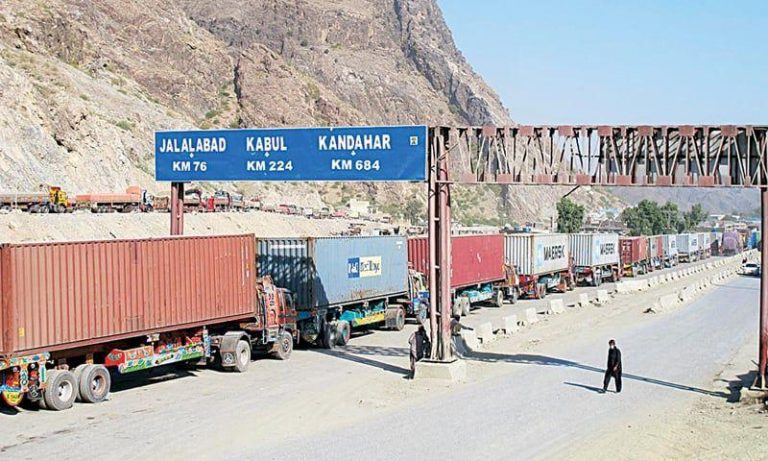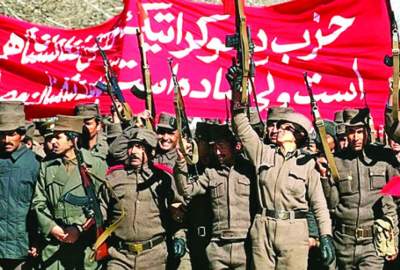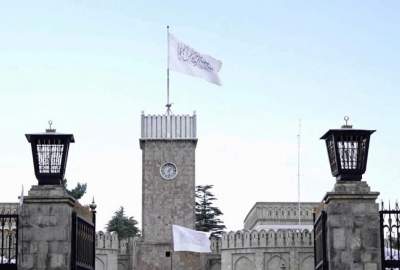Stable and robust trade and transit will benefit both countries regarding job creation, poverty reduction, taxes, cheap and qualitative products, etc.
Publish dateSunday 17 February 2019 - 04:45
Story Code : 179820
AVA- Afghanistan and Pakistan as two neighboring countries share strong cultural, religious, and trade relations for decades. The presence of over two million refugees in Pakistan, the almost 2500 kilometers Durand line, and the strong ethnic ties have made these two countries important to each other. Afghanistan as a landlocked country mostly relied on Pakistan for its international trade, but political tensions have always influenced the trade and transit process.
The Background
The landlocked countries mostly rely on neighboring countries for their international trade. Arvis et al. (2007) in their book “The Cost of Being Landlocked” mentions that landlocked countries have 50 percent higher transport cost than the coastal countries. Meanwhile, landlocked countries trade at average 30 percent less than the maritime countries. Moreover, being landlocked reduces economic growth by 1.5 percent.
To overcome the challenges, Afghanistan along with Bolivia and some other landlocked countries raised their voice in the several meetings of the United Nations for innocent passage to the ocean. Eventually, the United Nations requested the maritime countries to allow access to the seaside for the landlocked countries. As a result, the First official agreement on transit and trade (ATTA) was signed on March 2, 1965, between Afghanistan and Pakistan. The ATTA allowed Afghanistan to use the territory of Pakistan for the export and import of goods. According to the ATTA agreement, Afghanistan could use the Torkham and Chaman border points as exit points while the Karachi and Gawadar ports as entry points.
Notwithstanding, it had certain restrictions. The restrictions were (1) Afghan trucks were not allowed to carry goods to Pakistani ports; the transportation was controlled by the National Logistic Cell (NCL), (2) Trade with India via Wagah was not finalized,(3) Pakistan was not allowed to trade with Central Asian Countries through Afghanistan.
India has remained a strong economic and political partner of Afghanistan. Hence, Afghanistan needed to trade with India via the Wagah border. Meanwhile, Pakistan had an incentive to trade with Central Asian countries via Afghanistan. Therefore, both the countries started negotiations over a new agreement. After a few rounds of talks, the ATTA agreement was replaced by APTTA (Afghanistan and Pakistan transit and trade agreement) on 28 October 2010. The APTTA agreement allowed Pakistan to trade with Central Asia via the Islam Qala, Turghundi, Hairatan, Zaranj, Aqina, and some other Ports of Afghanistan. Meanwhile, Afghanistan could export goods to India via the Wagah border, but the exports of India were not allowed to be carried to Afghanistan. Moreover, Afghanistan could use the Karachi and Gawadar ports as entry points along with Wagah port. Also, Afghan trucks were allowed to carry goods to Pakistani ports while trade with China via Sost (Pakistan and China border point) was finalized.
After APTTA
Although the agreement was signed, still the trade and transit relation of the two neighboring countries have remained unstable. The sudden closure of borders, unnecessary delay of goods in the customs of Pakistan, tensions in a trade with India, extortion fees, strict security check system, and some other factors pushed the trade relations to an unstable situation. However, Afghanistan was forced to explore alternative ways to initiate its international trade. As trade data from the statistical yearbook of Central Statistics Organization of Afghanistan (CSO, 2015-2016) shows, Pakistan was the largest trading partner of Afghanistan until 2016, while after the year 2016 the trade and transit volume sharply declined. Further, the data discloses that imports from Pakistan rose to 1.19 billion dollars in 2016, whereas, Pakistan received 283 million dollars’ worth of goods from Afghanistan.
Moreover, the total trade volume jumped from 0.74 billion dollars to more than 2 billion dollars throughout 2008 – 2012. The trade between the two neighboring countries was huge during the year 2008- 2012 but when President Ashraf Ghani came to power, transit has been shifted to other countries while the bilateral trade with Pakistan has adversely affected which caused the trade and transit volume to be reduced sharply.
The Role of Chabahar and Aqina Port
The strategic competition between China and India has offered projects like Chabahar and CPEC (China-Pakistan Economic Corridor). The CPEC will allow China to trade with Central Asia, the Middle East, and European countries via the Gawader port of Pakistan. On the other hand, India committed to investing in the Chabahar project which will provide access to Central Asia and Afghanistan for India. The Chabahar not only benefits India and Iran, but it also provides an alternative way for Afghanistan to trade with its ally (India) and European countries. The Chabahar project formally signed on May 23, 2016, in the presence of Narendra Modi, Ashraf Ghani, and Hassan Rohani. Furthermore, the establishment of Aqina Port in the north region of Afghanistan gave an incentive to Afghan businessmen to import goods from Central Asian counties especially from Turkmenistan while the new Lapis Lazuli route is another alternative way for Afghanistan to trade with other countries. As a result of the shift in the transit directions, the bilateral trade volume of Afghanistan and Pakistan stood at only 500 million dollars at the beginning of the year 2018, and it might fall even more.
Current Situation and The need for Arrangements
Currently, the economy of Pakistan suffers from lack of foreign exchange reserves, trade deficit, and a burden of debt while despite an improvement in exports and domestic revenues, still, the economy of Afghanistan suffers from the huge trade deficit, extreme poverty, and unstable security and political environment. The current low volume of bilateral trade and the volatile political environment will not benefit the economy of either country. Whereas, Pakistan shares strong religious and cultural relations with Afghanistan. Hence, both countries can benefit from stable and robust trade and transit relations. A report published by Business Today, have shown that if Pakistan and India remove the non-tariff barriers to trade, the bilateral trade volume will increase to 30 billion dollars instead of the current 5 billion dollars. In similar ways, Afghanistan and Pakistan have the potential to trade with each other by a large volume. If the relations remain strong and stable, Afghanistan will benefit from cheap and easy transit via Karachi and Wagah port while Pakistan will benefit from trade with Central Asian Countries via Afghan ports. Therefore, both countries need to relook at the poor trade and transit relations and make arrangements in policies for mutual benefits. Henceforth, Strong and stable trade and transit will benefit both countries regarding job creation, poverty reduction, taxes, cheap and qualitative products, etc.
The Background
The landlocked countries mostly rely on neighboring countries for their international trade. Arvis et al. (2007) in their book “The Cost of Being Landlocked” mentions that landlocked countries have 50 percent higher transport cost than the coastal countries. Meanwhile, landlocked countries trade at average 30 percent less than the maritime countries. Moreover, being landlocked reduces economic growth by 1.5 percent.
To overcome the challenges, Afghanistan along with Bolivia and some other landlocked countries raised their voice in the several meetings of the United Nations for innocent passage to the ocean. Eventually, the United Nations requested the maritime countries to allow access to the seaside for the landlocked countries. As a result, the First official agreement on transit and trade (ATTA) was signed on March 2, 1965, between Afghanistan and Pakistan. The ATTA allowed Afghanistan to use the territory of Pakistan for the export and import of goods. According to the ATTA agreement, Afghanistan could use the Torkham and Chaman border points as exit points while the Karachi and Gawadar ports as entry points.
Notwithstanding, it had certain restrictions. The restrictions were (1) Afghan trucks were not allowed to carry goods to Pakistani ports; the transportation was controlled by the National Logistic Cell (NCL), (2) Trade with India via Wagah was not finalized,(3) Pakistan was not allowed to trade with Central Asian Countries through Afghanistan.
India has remained a strong economic and political partner of Afghanistan. Hence, Afghanistan needed to trade with India via the Wagah border. Meanwhile, Pakistan had an incentive to trade with Central Asian countries via Afghanistan. Therefore, both the countries started negotiations over a new agreement. After a few rounds of talks, the ATTA agreement was replaced by APTTA (Afghanistan and Pakistan transit and trade agreement) on 28 October 2010. The APTTA agreement allowed Pakistan to trade with Central Asia via the Islam Qala, Turghundi, Hairatan, Zaranj, Aqina, and some other Ports of Afghanistan. Meanwhile, Afghanistan could export goods to India via the Wagah border, but the exports of India were not allowed to be carried to Afghanistan. Moreover, Afghanistan could use the Karachi and Gawadar ports as entry points along with Wagah port. Also, Afghan trucks were allowed to carry goods to Pakistani ports while trade with China via Sost (Pakistan and China border point) was finalized.
After APTTA
Although the agreement was signed, still the trade and transit relation of the two neighboring countries have remained unstable. The sudden closure of borders, unnecessary delay of goods in the customs of Pakistan, tensions in a trade with India, extortion fees, strict security check system, and some other factors pushed the trade relations to an unstable situation. However, Afghanistan was forced to explore alternative ways to initiate its international trade. As trade data from the statistical yearbook of Central Statistics Organization of Afghanistan (CSO, 2015-2016) shows, Pakistan was the largest trading partner of Afghanistan until 2016, while after the year 2016 the trade and transit volume sharply declined. Further, the data discloses that imports from Pakistan rose to 1.19 billion dollars in 2016, whereas, Pakistan received 283 million dollars’ worth of goods from Afghanistan.
Moreover, the total trade volume jumped from 0.74 billion dollars to more than 2 billion dollars throughout 2008 – 2012. The trade between the two neighboring countries was huge during the year 2008- 2012 but when President Ashraf Ghani came to power, transit has been shifted to other countries while the bilateral trade with Pakistan has adversely affected which caused the trade and transit volume to be reduced sharply.
The Role of Chabahar and Aqina Port
The strategic competition between China and India has offered projects like Chabahar and CPEC (China-Pakistan Economic Corridor). The CPEC will allow China to trade with Central Asia, the Middle East, and European countries via the Gawader port of Pakistan. On the other hand, India committed to investing in the Chabahar project which will provide access to Central Asia and Afghanistan for India. The Chabahar not only benefits India and Iran, but it also provides an alternative way for Afghanistan to trade with its ally (India) and European countries. The Chabahar project formally signed on May 23, 2016, in the presence of Narendra Modi, Ashraf Ghani, and Hassan Rohani. Furthermore, the establishment of Aqina Port in the north region of Afghanistan gave an incentive to Afghan businessmen to import goods from Central Asian counties especially from Turkmenistan while the new Lapis Lazuli route is another alternative way for Afghanistan to trade with other countries. As a result of the shift in the transit directions, the bilateral trade volume of Afghanistan and Pakistan stood at only 500 million dollars at the beginning of the year 2018, and it might fall even more.
Current Situation and The need for Arrangements
Currently, the economy of Pakistan suffers from lack of foreign exchange reserves, trade deficit, and a burden of debt while despite an improvement in exports and domestic revenues, still, the economy of Afghanistan suffers from the huge trade deficit, extreme poverty, and unstable security and political environment. The current low volume of bilateral trade and the volatile political environment will not benefit the economy of either country. Whereas, Pakistan shares strong religious and cultural relations with Afghanistan. Hence, both countries can benefit from stable and robust trade and transit relations. A report published by Business Today, have shown that if Pakistan and India remove the non-tariff barriers to trade, the bilateral trade volume will increase to 30 billion dollars instead of the current 5 billion dollars. In similar ways, Afghanistan and Pakistan have the potential to trade with each other by a large volume. If the relations remain strong and stable, Afghanistan will benefit from cheap and easy transit via Karachi and Wagah port while Pakistan will benefit from trade with Central Asian Countries via Afghan ports. Therefore, both countries need to relook at the poor trade and transit relations and make arrangements in policies for mutual benefits. Henceforth, Strong and stable trade and transit will benefit both countries regarding job creation, poverty reduction, taxes, cheap and qualitative products, etc.
avapress.com/vdcgxy9qzak9u74.5jra.html
Tags
Top hits












